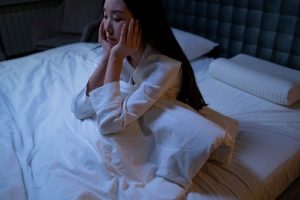 22 million Americans suffer from sleep apnea; however, 80% of cases aren’t diagnosed. Obstructive sleep apnea (OSA) is the most common type, which is caused by an obstruction in the upper airway from the soft tissues in the back of the mouth. Men are 2 to 3 times more likely to have it than women, but it can affect anyone, no matter their age or gender. Untreated sleep apnea is associated with several potentially life-threatening conditions, like heart disease, but now there’s another danger, especially for women. Researchers have found a connection between OSA and cancer in women.
22 million Americans suffer from sleep apnea; however, 80% of cases aren’t diagnosed. Obstructive sleep apnea (OSA) is the most common type, which is caused by an obstruction in the upper airway from the soft tissues in the back of the mouth. Men are 2 to 3 times more likely to have it than women, but it can affect anyone, no matter their age or gender. Untreated sleep apnea is associated with several potentially life-threatening conditions, like heart disease, but now there’s another danger, especially for women. Researchers have found a connection between OSA and cancer in women.
What is Obstructive Sleep Apnea?
The most prevalent form of sleep apnea results from a blockage in the upper airway. The muscles in the back of the mouth or tongue relax while sleeping, which can cause them to block the airway. As a result, it can cause frequent interruptions in breathing while sleeping. Each pause in breathing depletes the body of oxygen, leading to several mental and physical complications without any treatment.
Cancer Risks for Women
HealthDay News recently published a study indicating the connection between low blood oxygen levels and the biology of certain cancers. Researchers analyzed data from 19,000 European sleep apnea patients to find a link between the severity of OSA’s role in cancer risks. Researchers found people with oxygen saturation levels below 90% were more likely to be diagnosed with cancer than those without the sleep disorder. Their research discovered cancer was also more prevalent among females with OSA.
Although further research is needed, there’s an association between OSA and cancer in women. While the cancer occurrence was less than 2%, it’s important to remain vigilant for any signs of the sleep disorder because symptoms can be less noticeable in females.
Symptoms of Sleep Apnea
Symptoms of sleep apnea are diverse and look different for everyone, especially women. Men tend to experience snoring and sleepiness while females report fatigue, depression, and morning headaches. Women are more likely to have symptoms if they are overweight or after menopause. A simple sleep study can confirm a diagnosis to get the necessary treatment.
Treating OSA in Women
A CPAP machine is the most traditional method of treating sleep apnea. A mask is worn over the mouth or nose to deliver a gentle stream of air pressure to keep the airways open. Although it’s effective, it can be bothersome.
Many women prefer an oral appliance because it is discreet, comfortable, and convenient. The custom-fit device repositions the tongue and jaw to prevent an obstruction in the airway. Your sleep dentist can provide the oral appliance you need to safeguard your health and quality of life.
About Dr. West
Dr. West earned her dental degree at the University of Southern California Dental School and continued her education at many prestigious institutes, focusing on sleep medicine, full mouth reconstruction, and other advanced services. She is a member of various professional organizations due to her career excellence, including the American Academy of Sleep Medicine. Contact our office today to request your consultation for oral appliance therapy.
